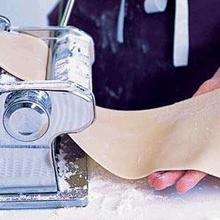
Basic Fresh Pasta
Ingredients:
2 1/2 cups plain flour
4 eggs at room temperature
extra flour, for dusting
Making fresh pasta is easy and enjoyable. You will need a pasta machine, which you can borrow or buy for about $60.
You can use ordinary plain flour, or Italian Dopio Zero (Double Zero).
Serves: 550g
Preparation time: 40 minutes
Method:
Sift the flour and salt together onto a clean work surface. Use your hands to shape the flour into a circular mound. Make a well in the centre. Place the eggs in the well and use a fork to lightly whisk. Use your fingertips to gradually blend a little flour into the egg mixture. Working with your fingertips, continue to gradually draw the flour into the centre (being careful the egg mixture does not run out of the well) until the mixture forms a dough. To check if the dough is the right consistency, press a clean, dry finger into the centre of the dough. If it comes out clean without being sticky, it is the right consistency. If not, knead in a little more flour and test again.
Lightly flour the surface if necessary. Firmly knead the dough by using the heel of your hand to firmly push down into it and then away from you. Lift the dough with your fingertips and fold it back on itself towards you. Turn the dough a half turn and repeat. Continue and repeat. Continue kneading the dough for 6-7 minutes or until smooth and elastic. Kneading is an important part of the pasta-making process as it develops the gluten in the flour, giving the pasta a firm, tender texture. Divide the dough into 4 equal portions and wrap each portion in plastic wrap or cover with a clean, damp tea towel. This will prevent the dough from drying out. Set aside for 10 minutes to rest. This helps make the pasta more pliable and easier to roll out.
Attach a pasta machine to the side of a workbench and adjust the machine's rollers to the widest setting. Spread about 4 clean, dry tea towels over the work surface close to the pasta machine. Unwrap a portion of dough and use the palm of your hands to flatten it into a rectangle. Dust the rollers with flour and roll the dough portion through. Dust again with flour and repeat on the same setting. Fold in the shorter sides of the dough to meet in the centre to form a smaller rectangle and feed through the machine again. Repeat this process 5-6 times or until smooth.
Reduce the width between the rollers by 1 and roll the dough through as before. Repeat the process, reducing the setting each time until the dough is 1-1.5mm thick. The settings on all pasta machines vary. The last setting on some machines may roll the dough too thin, resulting in it sticking to the rollers and tearing. So be careful to only reduce the setting and roll the dough until it reaches the desired thickness.
Spread the pasta sheet over the clean tea towels. When laying out the pasta sheets, they must not touch or overlap each other as the moist pasta will stick together. Repeat steps 3-4 with the remaining portions of dough. Set the pasta sheets aside for 10-15 minutes (depending on the temperature in your kitchen) or until dry enough not to stick together but pliable enough not to crack. Trim the edges of the pasta. Cut into 14 x 25cm pieces to make lasagne sheets or see step 6 to make fettuccine.
To cut the pasta into fettuccine by hand, loosely roll up a pasta sheet starting from the shortest end. Trim the ends and discard. Use a sharp knife to cut the pasta crossways at 5mm intervals. Unravel the pasta. To cut pasta into fettuccine using the pasta machine, you will need a fettuccine cutting attachment. Fit the machine with the attachment and feed the pasta sheets, one at a time, through the fettuccine attachment. Cook immediately or store individual portions as loose nests.
Variations:
Beetroot pasta - Omit 2 eggs. Place 180g drained canned whole baby beetroot in a blender or food processor and process, scraping down the side occasionally, until pureed. Add with eggs in step 1.
Fresh chilli & coriander pasta - Add 3/4 tsp chilli flakes and 1/3 cup loosely packed fresh coriander leaves with the eggs in step 1.
Fresh herbed pasta - Make the basic pasta recipe to the end of step 4. Gently press 5 mint leaves, 9 coriander leaves and 1 1/2 tsp snipped fresh chives in a single layer over half of each sheet of pasta. Fold pasta over and roll through pasta machine once more to enclose herbs.
Fresh pesto pasta - Place 1/2 cup loosely packed fresh basil leaves, 1 crushed garlic clove, 2 tbs finely grated parmesan and 1 1/2 tbs toasted pine nuts in the bowl of a food processor and process until finely chopped. Add the basil mixture with the eggs in step 1.
Fresh spinach pasta - Omit 1 egg. Trim 1 bunch English spinach and wash leaves. With water still clinging to the leaves, cook in a medium saucepan over low heat for 3-4 minutes or until it just wilts. Set aside for 10 minutes to cool slightly. Use your hands to squeeze out any liquid. Finely chop the spinach and add with eggs in step 1.
Fresh sundried tomato pasta - Omit 1 egg. Add 75g (1/4 cup) sundried tomato pesto with the eggs in step 1.
Orange pasta - Add 1 tsp finely grated ornage rind with eggs in step 1.
Saffron pasta - Combine 1/4 tsp saffron threads with 1 tbs warm water. Stand for 5 minutes. Add saffron water and threads with eggs in step 1.
Contributor: Cam
